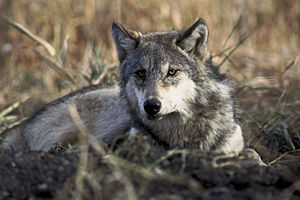 Image via Wikipedia
Image via Wikipedia
The dog, Canis lupus familiaris, nicknamed Man's Best Friend, is a domesticated subspecies of the Gray Wolf, a member of the Canidae family of the order Carnivora. The term is used for both wild and pet varieties. The domestic dog is one of the most widely kept working and companion animals in human history.
 natomy and behavior had been shaped by environmental factors and functional roles. As modern genetics developed, humans began to breed dogs for a wide range of specific traits, leading to the development of hundreds of varied breeds showing more behavioral and morphological variation than any other land mammal. For example, height ranges from a few inches in the Chihuahua to a few feet in the Irish Wolfhound; color varies from white through grays to black, and browns from light (tan) to dark ("red" or "chocolate") in a wide variety of patterns; coats can be short or long, coarse-haired to wool-like, straight, curly, or smooth. Most breeds commonly shed this coat, but non-shedding breeds are also popular.
natomy and behavior had been shaped by environmental factors and functional roles. As modern genetics developed, humans began to breed dogs for a wide range of specific traits, leading to the development of hundreds of varied breeds showing more behavioral and morphological variation than any other land mammal. For example, height ranges from a few inches in the Chihuahua to a few feet in the Irish Wolfhound; color varies from white through grays to black, and browns from light (tan) to dark ("red" or "chocolate") in a wide variety of patterns; coats can be short or long, coarse-haired to wool-like, straight, curly, or smooth. Most breeds commonly shed this coat, but non-shedding breeds are also popular.
 erarchy, exhibiting postures and nonverbal communication that reveal their states of mind. These sophisticated forms of social behavior and communication explains their trainability, playfulness, and ability to fit into human households and social situations and have earned dogs a unique relationship with humans.
erarchy, exhibiting postures and nonverbal communication that reveal their states of mind. These sophisticated forms of social behavior and communication explains their trainability, playfulness, and ability to fit into human households and social situations and have earned dogs a unique relationship with humans.
Scientific evidence for the evolution of the domestic dog comes from archaeological findings and mitochondrial DNA studies, indicating that the domestication of dogs from their wolf ancestors occurred more than 15,000 years ago in the late Upper Paleolithic period, between 17,000  and 14,000 years ago. However, a wide range of contradictory findings make this issue controversial. In 2008, archeological evidence that a large, toothy canine existed 31,700 years ago and ate a diet of horse, musk ox and reindeer was unearthed from Goyet Cave in Belgium. Prior to this, the earliest dog fossils were two large skulls from Russia and a mandible from Germany dating roughly 14,000 years ago. Remains of smaller dogs from Natufian cave deposits in the Middle East have been dated to around 10,000 to 12,000 years ago. Fossils uncovered in Germany, the French Alps, and Iraq, and cave paintings in Turkey show that dogs existed throughout Europe and Asia roughly 8,000 to 10,000 years ago, indicating that dogs could have diverged from wolves much earlier than 15000 years ago.
and 14,000 years ago. However, a wide range of contradictory findings make this issue controversial. In 2008, archeological evidence that a large, toothy canine existed 31,700 years ago and ate a diet of horse, musk ox and reindeer was unearthed from Goyet Cave in Belgium. Prior to this, the earliest dog fossils were two large skulls from Russia and a mandible from Germany dating roughly 14,000 years ago. Remains of smaller dogs from Natufian cave deposits in the Middle East have been dated to around 10,000 to 12,000 years ago. Fossils uncovered in Germany, the French Alps, and Iraq, and cave paintings in Turkey show that dogs existed throughout Europe and Asia roughly 8,000 to 10,000 years ago, indicating that dogs could have diverged from wolves much earlier than 15000 years ago.
 is unknown. At least three early species of pre-humans began spreading out of Africa roughly 400,000 years ago, and thus lived for a considerable period in contact with canine species. Despite this, no evidence of any adaptation of canine species to the presence of the close relatives of modern man has been found.
is unknown. At least three early species of pre-humans began spreading out of Africa roughly 400,000 years ago, and thus lived for a considerable period in contact with canine species. Despite this, no evidence of any adaptation of canine species to the presence of the close relatives of modern man has been found.
![Reblog this post [with Zemanta]](http://img.zemanta.com/reblog_e.png?x-id=4ca1cd09-f8af-40a6-b70c-149a788b87e9)
No comments:
Post a Comment